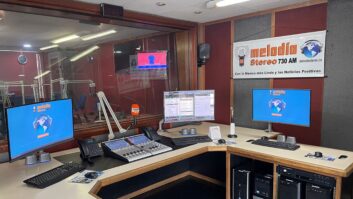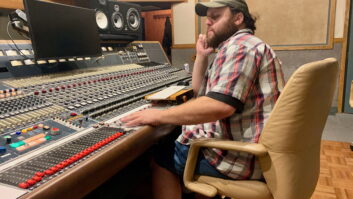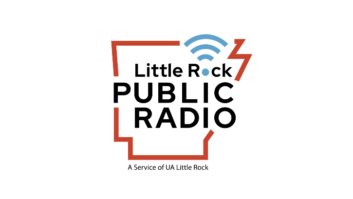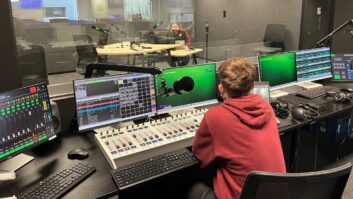The list of individuals who helped to lay the engineering foundations for radio is quite long and includes many familiar names. Sometimes, however, individuals who’ve made significant and long-lasting contributions don’t always receive the attention due them.

In this photo, circa 1909, a young Arthur Austin at left inspects one of the products being turned out by his employer, the Ohio Brass Company’s insulator division.
Photo courtesy Austin Insulators Inc.
One of those innovators in this “neglected” category is Arthur O. Austin, even though his inventions are still in use at radio stations around the world and his name still graces the signboard and letterheads of the company he founded more than 80 years ago.
A Google search turns up precious little about him, attesting to this relative level of his obscurity. I had introduced Austin in a previous article (see Bibliography reference [1] at the end of the article), and after additional research would like to shed additional light on his career and legacy.
Austin’s best-known invention is that special air-core transformer used for supplying lighting current to AM radio towers without shunting RF energy feeding to the radiator to ground. The device is properly known as the “Austin Ring Transformer,” but is usually just rendered as the “ring” or “lighting” transformer, omitting its inventor’s name. And rather curiously, it seems that Austin never bothered to secure a patent for this useful device.
Early on, Austin, a California native, appears never to have been interested in radio, even though the medium was beginning to receive a lot of attention about the time he took his engineering degree in 1903 from Stanford Leland University (now Stanford University).
After graduation, young man Austin immediately went east to take a position with the General Electric in Schenectady. However, the cold climate and company politics seemed not to have agreed with him, as within a year, he was back in his home state, working as an insulator inspector for the utility that is now Pacific Gas and Electric Co.
Austin’s personal history is a little murky at this point, but it appears this early exposure to insulator technology led him back east for employment with the Lima Insulator Co. in Lima, N.Y. After a fire destroyed that company’s factory in 1908, he journeyed to Ohio and a job at one of Lima’s competitors, the Akron Hi-Potential Porcelain Co., which in the course of a few years changed names several times, ultimately becoming the insulator division of the Ohio Brass Co.
A LIFELONG AFFECTION FOR INSULATORS

By 1933, Austin had acquired enough personal wealth to launch his own business, the Austin Insulator Company. A few years earlier he’d purchased the large and opulent estate of Barberton, Ohio’s founder, Ohio Columbus Barber (this is not a typo), and set up an outdoor testing laboratory on the estate grounds. Fortunately for Austin, there were no HOAs then!
Photo courtesy A.O. Austin family
Austin found his true niche with this employment, putting an end to any further job-hopping. (He remained in Ohio for the rest of his six-decade engineering career.) He apparently hit it off well with management, and this, coupled with his particular expertise in insulator design, provided him free rein for innovating and developing products for Ohio Brass. Austin soon began to amass patents in this field and made a name for himself within the insulator industry.
Patrick Warr, the current owner of the direct descendant company, now known as Austin Insulators Inc., described Austin as “the chief ceramicist at Ohio Brass, and someone who became wealthy enough to eventually leave that company and establish another one bearing his name.”
Austin’s particular expertise in analyzing insulator performance and design apparently was coupled with considerable business savvy, for as pointed out by Warr, Austin appeared to amass considerable personal wealth. By the 1920s, he was able to set up his own business, and as we will see, purchased a rather grandiose estate in the city of Barberton, where Ohio Brass’s insulator works were based.
MOVING INTO RADIO

Another view of the outdoor high voltage testing lab.
Photo courtesy A.O. Austin family
Despite his preoccupation with power line industry work, Austin was not oblivious to what was going on in radio. This is evidenced in one of the few surviving early Austin Insulator company records, an undated appendix to a licensing agreement:
“Mr. Austin early in his career began following very carefully the subject of radio insulation beginning with the Fessenden saddle insulators in 1904 since the requirements of radio insulation have played an important part in the design, manufacture and use of transmission insulation.”
Whatever grounding Austin had in radio certainly came in handy with the outbreak of “The Great War” in Europe in 1914 and America’s entry into the conflict 100 years ago this month. The new field of wireless communication was being exploited by all WWI players. Ohio Brass, along with Arthur Austin’s shop, found itself engaged in “war work.”
As hostilities grew, the United States government decided it might be prudent to construct a large military radio communication facility that was sited far enough away from the Atlantic coastline to reduce vulnerability to possible enemy invasion. The project was assigned to the Navy’s Department of Steam Engineering, which made the decision to locate the station at Monroe, N.C.
As the planned $3 million (more than $56 million in today’s money) facility included the installation of state-of-the-art Federal arc converters (transmitters) with outputs in the megawatt range [2], some serious antenna insulators would be required. Ohio Brass was selected as a supplier, and Austin was assigned to help with the development.

This “close-up” shows the construction of one of the glazed tile high-voltage transformer supports. It’s likely that it was a direct descendant of the insulated antenna supports designed by Austin for the never constructed World War I U.S. Navy radio station in North Carolina. The design may also have influenced Austin’s thoughts with regard to reviving Reginald Fessenden’s 1905 insulated-base vertical radiator antenna design.
Photo courtesy Austin Insulators Inc.
Design of insulators capable of withstanding extremely high RF potentials was not the only challenge facing Austin. The war was straining steel supplies, and Ohio Brass was asked to investigate the feasibility of constructing the necessary antenna support towers with clay structural tile [3]. (The Navy was also considering the use of brick columns as antenna support structures, with the upper portions constructed with “porcelain brick” to reduce RF losses [4].)
The war ended before the station could be built. However, the value and utility of radio were established by the war, with commercial broadcasting launching in a big way just a few years later.
During the 1920s, Austin became increasingly involved in radio-related projects. One of the more notable of these was the relocation of the transmitter plant of Cleveland’s WHK from the roof of a downtown office building to a relatively unpopulated area south of the city. Austin was brought in to design specialized antenna insulators and support structures. (The complete story is told in the Radio World article “A Most Unusual Transmitter Plant.” [5])
In 1933, a few years after completion of the WHK project, Austin decided to sever ties with Ohio Brass and start his own insulator business. Although the main focus of the new company was power line insulators, Austin continued to follow developments in radio, as evidenced in a 1935 paper (“The Effect of Radio on Transmission Line Insulation) presented at an international conference [6]. In the paper, Austin made note of his background in radio, stating that his work in developing insulators for high-power radio station applications had played a large role in the development of the power line insulator described in his paper.
“Owing to the very rapid development of radio broadcasting in the last few years it would seem that problems involving radio insulation would have little or no effect on insulation for high voltage transmission systems. However, it must be remembered that the early transatlantic stations were experiencing difficulties with [insulators] while the insulation for transmission lines was fairly satisfactory. The difficulty of providing insulation for pioneer radio stations led to developments which have since been applied directly to transmission lines.”
(Reginald Fessenden’s Brant Rock, Mass., facility is obviously one of these “early transatlantic stations,” as later in his paper, Austin cites the “saddle-type” insulator employed, or possibly devised, by Fessenden, who is credited with creating the world’s first insulated-base, series-fed vertical radiator. [7])
Austin also mentions his role in connection with the previously mentioned N.C. military radio station, describing the design and construction of a “sectionalized” antenna and even including a photograph of a model used for testing this concept. He noted especially the suggested use of “tile” as a construction material, stating that “studies were made so as to apply either a steel or tile tower using insulated zones.” He observed that the studies proved it would be possible to construct a “sectionalized” 800- or 1,000-foot tower, adding, “manufacturing capabilities have improved greatly since the studies were done.”
ANOTHER EARLY INSULATED-BASE VERTICAL RADIATOR?

Arthur O. Austin in later years. The picture was probably taken by one of the numerous fireplaces in the lavish 40-room French Renaissance Revival mansion he purchased from the Barber family. The home was demolished in 1965.
Photo courtesy A.O. Austin family
Although it appears that Austin is merely suggesting breaking up supporting masts for “flat top” antennas into isolated sections, in examining one of Austin’s “mockup” photographs one can’t but help wonder if he wasn’t influenced by Fessenden’s 1905 insulated-base vertical radiator.
By the mid-1930s, Austin was designing insulators capable of supporting very large structural loads and also presentimg low RF losses. He noted that it would be easy to attain heights of up to 1,000 feet (more than twice the height of Fessenden’s 1905 “smokestack” radiator). We shall probably never know for certain, and this leads back to the WHK transmitter relocation project.
The station’s chief engineer, E.L. Gove, hired Austin to design the antenna system at just about the time that CBS was placing its new insulated-base vertical radiator into service in New Jersey. As this radical new antenna design was generating considerable interest within the radio engineering community (featured in cover stories of two leading radio magazines), it would seem likely that Gove, Austin or possibly both would have known about the advantages afforded by such technology. Yet, the new WHK facility was constructed around a “traditional” flattop antenna.
Again, this is speculation, but it seems likely that Austin, in light of his background in radio and knowledge of transmission system efficiencies and shortcomings, would have lobbied for the vertical radiator. Was he overruled by the customer — WHK and Gove?
We do know that Austin was granted a patent for his sectionalized antenna mast design and that his company began to manufacture more and more specialty insulators for radio stations as they transitioned to vertical radiators. Austin continued to improve and innovate his radio insulator products, designing a “safety sleeve” tower base insulator that would keep a transmitting tower standing even if the outer ceramic element was shattered.
He also developed a heated, oil-filled radio tower insulator that minimized RF leakage in damp weather, thus helping to maintain the antenna’s radiation efficiency. Spokane’s KHQ became an early adopter of this heated insulator technology with deployment of a new 805-foot self-supporting tower in the early 1940s [8].
“THAT TRANSFORMER”

Patrick Warr, owner of Austin Insulator Inc., poses with one of his company’s tower lighting transformers.
However, unless they’re broken, radio tower insulators don’t really generate a lot of attention, so Austin’s work generally goes unacknowledged. His name does live on in connection with the specialized AC power transformer used to light insulated base radiators. He began producing these devices in the 1930s, and they’re still manufactured today by the company bearing his name.
So, what led Austin to invent this useful device?
This remains a bit of a mystery, as no documentation has been found among company records relating his reasons for developing the lighting transformer. We do know that the WHK twin-tower project proved problematic when nighttime lighting requirements were considered.
With conventional beacons and sidelights, the associated AC wiring would have defeated the purpose of sectionalizing the towers. Austin and Gove eventually solved the problem by lighting with gas flares and breaking up metal gas piping with short lengths of non-conductive tubing.
CBS solved its lighting problem by using an AC generator located within the ATU structure at the base of the 665-foot mast. The generator was insulated from ground and used an insulated coupling to connect it to its driving motor to keep tower light wiring from shunting RF to ground [9]. (According to Warr, such a “Rube Goldberg” scheme for lighting power isolation was also used well into the 1970s at some of the high-power stations operated U.S. Navy.)
Being the practical-minded engineer, Austin realized that neither gas lighting nor motor-generator sets constituted a really satisfactory solution, and applied his knowledge of power line electricity and transformers to create the air-core ring transformer.

The Austin ring transformer has been in constant production for more than 80 years. Here factory worker Omar Foster prepares a new order.
Photo courtesy Austin Insulators Inc.
Curiously, he seems not to have ever patented the device. Austin was issued patents for both electrically illuminating power transmission line towers and for a “ring” transformer, but neither makes reference to radio applications (and the “ring” transformer patent drawings don’t resemble his tower-lighting device in the slightest).
Warr offered his comments about this seeming oversight: “I’m not aware that there was ever any patent. There was a story related to me by my predecessors when I first came to work here. It seems that Arthur Austin was happily making ring transformers when he was approached by Hughey and Phillips, a company based somewhere around Los Angeles that was into several types of lighting. Austin told them he wasn’t interested in the West Coast market, as he had enough to do in Ohio, and told them how to make the transformer, and to ‘go ahead and make it.’ So, for many years, Hughey and Phillips made what was essentially the ‘Austin Ring Transformer.’ There were some distinct differences in the finish and support hardware, but if you took that away you ended up with a couple of air-spaced rings.
“They were just given the information,” said Warr. “If Arthur Austin was giving this information away, I don’t think he would have had a patent on it. Hughey and Phillips were very successful for a long time. Most of the U.S. government installations that I’ve come across built in the ’40s and 50s have their transformers. They’re easy to recognize, as they’re black and have some kind of rubberized coating on the outside and a different fitting [from Austin’s]. There are lots and lots of these around. I think Austin gave away a lot of business by telling them how to make the transformer.”
A LITTLE CORPORATE HISTORY

Workers Yanni Nikopoulos (R) and Omar Foster (L) at the present-day Austin Insulators Inc. prepare an 8-foot-diameter, 8-inch cross-section grading ring for reinstallation on a large, oil-filled version of Austin’s original ring lighting transformer. The transformer is designed for a 350-kV gradient.
In explaining why Austin’s insulator and transformer company had moved north of the border, Warr noted that following Austin’s 1964 death, his heirs weren’t that interested in the business and decided to shut it down. A U.K. company, Decca, which had been using specialized insulators from Austin in their radio navigation systems, was faced with the loss of this critical element and elected to purchase the company and collocate it with another of Decca’s operations in Canada. Following several ownership changes, Warr, who’d begun his electronics career as a Decca technician in the 1960s, eventually purchased the operation and is still producing insulators and lighting transformers for the radio industry.
Warr observed that as radio broadcasting migrated to FM, demand for tower insulators shrank and several former competitors moved away from RF products, leaving Austin as the sole supplier.
“So here we are today, essentially the only active manufacturer of radio insulators in the world with this long, rich legacy,” said Warr, adding that his present-day customers are largely international entities with powerful transmitters used for radio broadcsting, navigation and timing applications, along with naval radio stations employing high-power VLF transmitters for communicating with submerged submarines.
Austin Insulators is also now the sole supplier of the Austin Ring Transformer.
“One of the beauties of this company is that it has this wonderful history going back to the early 1900s,” said Warr. “And fortunately, here we are, almost the last man standing and still going strong.”
The author acknowledges the contributions of Patrick Warr and Austin Insulators Inc.; Sarah B. Hays of the Barberton (Ohio) Public Library; Jane Johnson of the Charlotte (N.C.) Mecklenburg Library; and Pamela O’Neal.
James E. O’Neal is a retired broadcast engineer who worked in that field for some 37 years before joining Radio World’s sister publication TV Technology to serve as its technology editor for nearly a decade. He is a regular contributor to both publications.
REFERENCES
Hays, Sarah B., “A. O. Austin: Electrical Wizard,” Sept. 2015 lecture presentation. Unpublished.
BIBLIOGRAPHY
[1] O’Neal, James E., “A Most Unusual Transmitter Plant,” Radio World Engineering Extra, Feb. 18, 2015.
[2] Hearings before Committee on Naval Affairs of the House of Representatives, on estimates submitted by the Secretary of the Navy, 1918; Government Printing Officer.
[3] From a caption associated with a photograph in the Austin Insulator Company archives. The photograph is labeled “N-921” and depicts a tapered “light house” tower that appears to be at least 50-feet high and is crowned with a very large power-line type of transformer. The photo information notes that information gained through experimentation with this tower was used in the both Monroe, N.C. project and later in the WHK transmitter relocation in Cleveland.
[4] Howeth, Capt. Linwood S. USN, retired., “History of Communications — Electronics in the United States Navy,” University of Michigan Library, 1963, chapter 20. (Howeth’s account mentions that the 20 support structures were to be built in the form of 500-foot tall brick “chimneys,” with bases large enough to house the power plant and two megawatt arc transmitter equipment. The top sections were to be constructed with special “porcelain brick” [possibly from the Ohio Insulator works and one of the reasons that Austin was brought into the project]. Howeth further notes that before the war’s ending shut down the project “the future output of the many brickyards in the South had been placed under contract” to support the construction. Interestingly, the “light house” tower structure shown in the “N-921” photograph is quite possibly a scale model of planned radio chimneys.)
[5] Ibid — O’Neal, James E., “A Most Unusual Transmitter Plant.”
[6] Austin, Arthur O., “The Effect of Radio Upon Transmission Line Insulation.” This paper was presented during the June 27–July 6, 1935 Conférence International des Grands Réseaux Électriques á Haute Tension (International Conference on Large High Voltage Electric Networks) held in Paris.
[7] O’Neal, James E.,”Fessenden — The Next Chapter,” Radio World, Dec. 23, 2008, pp. 18-23.
[8] “Heated Insulators Safeguard Radio-Range Beacons,” Popular Science, Dec. 1941, pp. 122-123.
[9] “WABC’s New ‘Wire-less’ Antenna,” Siemans, Frederick, Radio News, Dec. 1931, pp. 462, 463 and 512.







